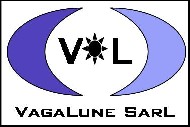| Link Budget |
| |
| Both the Lunar Module (LM) and Moon Rover (MR) will communicate back to Earth at the Allen Telescope Array (ATA) at the Hat Creek Radio Observatory in northern California. The ATA is a SETI institute center that is allowing use of its facilities to the competition. |
| General Link Parameter |
Value |
Unit |
Power Loss/Gain (dB) |
| Transmit bandwidth |
50 |
MHz |
-- |
| ATA to LM/MR uplink freq |
2119 |
MHz |
-38.97 |
| LM/MR to ATA downlink freq |
2278.5 |
MHz |
-39.60 |
| Earth to Moon path length |
378x106 |
m |
-171.5 |
| Moon Parameter |
Value |
Unit |
Power Loss/Gain (dB) |
| Moon Blackbody Temp |
274.5 |
K |
-127.2 |
| MR antenna (on uplink) |
0.3 (diameter) |
m |
6.47 |
| MR antenna (on downlink) |
0.3 (diameter) |
m |
7.10 |
| ATA Parameter |
Value |
Unit |
Power Loss/Gain (dB) |
| ATA antenna Temp |
45 |
K |
-135.1 |
| ATA antenna (on uplink) |
6.1 (diameter) |
m |
41.21 |
| ATA antenna (on downlink) |
6.1 (diameter) |
m |
41.84 |
|
| |
| Using the values above, equations and the diagram below, we estimate that to receive -80dBm of power at the ATA, our assumed 30cm dish antenna must transmit (Ptrans,dBm) -6.99 dBm or 200 μW of power. |
| |
 |
| The above diagram shows the link between the Earth and the Moon and the relative parameters used in the link budget calculations (for the Matlab file linked below). The uplink and downlink frequencies were chosen (S-band) because they were successfully used in information transmissions on the Apollo missions. Below is a listing of the various equations used to help in calculating the link budget for this system.
|
 |
| Equation 1 is a restatement of the Shannon Channel Capacity. Equations 2 and 3 are variations of the Friis Link Equation (in decibel format). Equation 4 gives the gain for an antenna dependent on the physical area and efficieny. Equation 5 calculates the noise power dependent on object temperature. Equation 6 gives the signal-to-noise ratio (SNR) used for equation 1. Notice that it is a ratio of powers in Watts and not a decibel value. Equations 7 and 8 are the constants used for free-space speed of light and the Stefan-Boltzman constant, respectively.
|
| M-File to determine various link budget parameters |
| |


